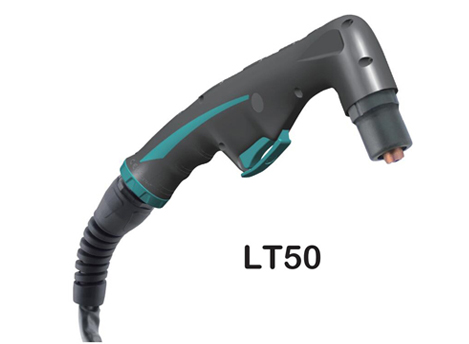In cutting electrically conductive metals, the plasma cutting process uses this conductive gas to transfer energy from the power supply through the plasma cutting torch to the metal to be cut.
A basic plasma arc cutting system consists of a power supply, an arc starting circuit and a torch. These system components provide the electrical energy, ionisation functions and process control required to cut a wide range of different materials in a high quality and efficient manner.
The power supply used in the plasma process is a constant current DC supply with an open circuit voltage of typically 240 VDC to 400 VDC The output current (amperage) of the power supply determines the capability of the system in terms of cutting speed and thickness of cut. The main function of the power supply is to provide the appropriate amount of energy to maintain the plasma arc after ionisation.
The arc starting circuit is a high frequency generator circuit capable of outputting 5000 to 10000 volts AC at a frequency of approximately 2 MHz. This voltage is used to create a high energy arc inside the torch, ionising the gas and thus producing plasma.
The torch is used to hold wearable parts such as nozzles and electrodes and to cool these parts (air or water cooled). Nozzles and electrodes are used to compress and maintain the plasma jet.

The working process of a plasma cutting machine
The power supply and arc starting circuit are connected to the torch by interconnecting wires and cables. These wires and cables feed the torch with the airflow, current and high frequencies required to start and maintain the plasma cutting process.
1. A start input signal is sent to the power supply. This simultaneously creates an open circuit voltage at the torch end and induces a flow of gas to the torch. The open circuit voltage can be measured by the voltage between the electrode (-) and the nozzle (+). Please note: The nozzle is connected to the positive side of the power supply via a resistor and a relay (arc guide relay), while the metal to be cut (workpiece) is connected directly to the positive side of the power supply. The gas passes through the nozzle and out of the orifice. At this point there is no arc yet, because the DC voltage does not yet have a current path.
2. Once the gas flow has stabilised, the high frequency circuit is activated. The high frequency arc cuts off the path between the electrode inside the torch and the nozzle, causing the gas to pass through this arc before it can exit the nozzle. The energy transferred to the gas by the high-frequency arc ionises the gas and creates an electrical conductivity. This conductive gas creates a current path between the electrode and the nozzle, resulting in the final plasma arc. The gas flow forces the plasma arc out through the nozzle orifice, creating a guided arc.
3. Assuming the nozzle is close enough to the workpiece, the guided arc will connect to the workpiece because the current path to the positive electrode (on the power supply) is not limited by the resistor as the positive nozzle connection would be. The current flowing through the workpiece is sensed by the electronics at the power source. Once the current is sensed, the high frequency circuit is disabled and the arc guide relay is opened. The ionisation of the gas is then maintained by the energy released from the DC arc of the power supply.
4. The temperature of the plasma arc melts the metal and penetrates the workpiece, while the high velocity gas stream flushes out the slag at the bottom of the cut. At this point, the torch will start moving and the cutting process begins.






